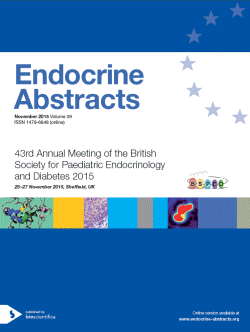
Society for Endocrinology BES 2015
Edinburgh,
UK
02 Nov 2015 - 04 Nov 2015

Poster Presentations
Bone
ea0038p1 | Bone | SFEBES2015
FHH3-associated AP2σ mutations impair MAPK signalling pathways
Rogers Angela , Gorvin Caroline , Whyte Michael , Thakker Rajesh
ea0038p2 | Bone | SFEBES2015
Exploring the N-ethyl-N-nitrosourea mutagenesis DNA archive for mutations in nuclear factor I/X to derive mouse models for Marshall-Smith syndrome
Kooblall Kreepa , Stevenson Mark , Piret Sian , Potter Paul , Cox Roger , Brown Steve , Hennekam Raoul , Thakker Rajesh
ea0038p3 | Bone | SFEBES2015
Reduction in daily hydrocortisone dose in adrenal insufficiency improves significantly bone mineral density – results from a 2-years prospective trial
Schulz Julia , Koetz Kathrin , Ventz Manfred , Diederich Sven , Quinkler Marcus
ea0038p4 | Bone | SFEBES2015
Mutations in G-protein subunit αq (GNAQ) are not a cause of familial hypocalciuric hypercalcaemia
Modi Manish , Cranston Treena , Rogers Angela , Howles Sarah , Gorvin Caroline , Thakker Rajesh
ea0038p5 | Bone | SFEBES2015
Soy protein with isoflavones reduce bone turnover markers in women during their early menopause – a randomised double blind parallel study
Sathyapalan Thozhukat , Aye Mo , Kilpatrick Eric S , Rigby Alan S , Fraser William D , Thatcher Natalie J , Atkin Stephen L
ea0038p6 | Bone | SFEBES2015
Increased circulating sclerostin levels in type 2 diabetic rats are not associated with changes in bone sclerostin production
Pereira Marie , Gohin Stephanie , Lund Nina , Hvid Anne , Smitham Peter , Oddy Michael , Reichert Ines , Chenu Chantal
ea0038p7 | Bone | SFEBES2015
Differential effects of parathyroid hormone on key regulators of osteoblast mineralisation
Houston Dean , Myers Katherine , MacRae Vicky , Millan Jose Luis , Staines Katherine , Farquharson Colin
ea0038p8 | Bone | SFEBES2015
Type 2 diabetes, bone mineral density and disc height
ea0038p9 | Bone | SFEBES2015
The decreased plasma levels of sclerostin but not Dickkopf-1 are associated with increased risk of osteoporotic fracture and lower bone mineral density in Korean postmenopausal women
Lim Yejee , Koh Jung-Min , Kim Beom-Jun , Kang Moo-Il , Lee Seung Hun , Baek Ki Hyun , Rhee Yumie , Min Yong-Ki , Kim Deog-Yoon , Kim Chong Hwa
ea0038p10 | Bone | SFEBES2015
A mutation in the calcium sensing receptor (previously known to cause neonatal severe hyperparathyroidism in the homozygote state) causing familial benign hypocalciuric hypercalcaemia in the heterozygote
Hinnie John , Gallagher Andrew , Collie Angela
ea0038p11 | Bone | SFEBES2015
The effect of oestradiol circadian rhythm on the bone mineral density of adult males
Wijetilleka Sajini , Khan Muhammad , Mon Aung , Joseph Frank , Fraser William , Vora Jiten
ea0038p12 | Bone | SFEBES2015
Familial hypocalciuric hypercalcaemia due to AP2S1 mutation in a patient with failed parathyroidectomies: a case report
Chinnasamy Eswari , Hurley Paul , Snape Katie , Bano Gul
ea0038p13 | Bone | SFEBES2015
Pre-operative localisation of parathyroid adenomas in patients with primary hyperparathyroidism: can a single modality of imaging be adequate?
Imran Hafsa , Wilson Paul , Sinha Rebecca , Varughese George , Nayak Ullal , Varadhan Lakshminarayanan
ea0038p14 | Bone | SFEBES2015
A rare presentation of primary hyperparathyroidism
Jahagirdar Vidhya R , Gittoes Neil J
ea0038p15 | Bone | SFEBES2015
Lessons learnt after ‘failed’ parathyroidectomy
Ugur Antonia , Dave Rajiv , Ashmore Daniel , Pereira Olivia , Ali Deedar
ea0038p16 | Bone | SFEBES2015
Melorrheostosis: a rare cause of bone pain and limb deformity
Shah Vinit Kirankumar , Gittoes Neil
ea0038p17 | Bone | SFEBES2015
Denosumab improves bone density in a female patient with severe anorexia nervosa
Jamieson Andrew , Pelosi Anthony , Weatherdon Georgina
ea0038p18 | Bone | SFEBES2015
Improved glycaemia following parathyroidectomy for primary hyperparathyroidism
Mahto Rajni , Raja Umar , Markham Deborah



